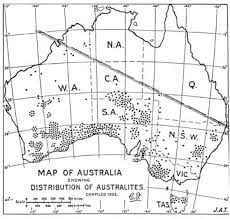Tektites are terrestrial debris ejected during the formation of an impact crater.
During the extreme conditions created by an extraterrestrial, hypervelocity impact, sediments near the surface and rocks were either melted, vaporised, or some combination of these and ejected from the impact crater high above the atmosphere.
After ejection from the crater, the material formed small (millimeter- to centimeter) bodies of molten material, that, as they re-entered the atmosphere, rapidly cooled to form tektites that fell to Earth to create a layer of ‘distal ejecta’ hundreds or thousands of kilometers away from the impact site.
- Australites
Australites are tektites found in Australia. They are mostly dark or black, and have shapes including discs and bowls that are not seen in other tektites. NASA used the shape of ‘flanged button’ australites in designing re-entry modules for the Apollo program in the 1960s.
- Australite
Indigenous Australians termed australites ooga (‘staring eyes’), and they were used as sacred objects or as cutting tools.
Europeans found out about australites in 1857, when explorer Thomas Mitchell gave naturalist Charles Darwin a mysteriously shaped piece of natural black glass. Darwin thought that australites were of volcanic origin due to their similarity to obsidian, volcanic glass. Later, australites were called blackfellows’ buttons and obsidian bombs.
One of the first scientists to seriously study australites was Charles Fenner, who saw his first australite in 1907. He believed that australites were glass meteorites.
Early theories about the source of australites included volcanoes, the bushfires that are common in Australia, or fusion of sand by lightning (fulgurites). Some scientists believed them to be meteorites, possibly lunar meteorites ejected from the Moon in impacts (disproved once the different composition of lunar rocks was ascertained).
Although there are still different theories about the origin of australites, most scientists now believe that australites formed during a large asteroid or comet impact on the Earth, as outlined above. The impact ejected myriads of small rocks right out of the Earth’s atmosphere. The australites acquired their streamlined, aerodynamic forms when they re-entered the Earth’s atmosphere while molten and travelling at high velocities.
Most australites are found in Southern Australia, below 25 degrees latitude. They represent the southern edge of the vast Australasian tektite strewnfield that stretches from southern China to Australia and is the result of an impact in Indochina.
- Distribution of Australites
The primary forms of australites are sphere, oval, boat, dumbbell and teardrop. Australites are smaller than other tektites and different in shape.
SOURCE
Wikipedia, Retrieved 21 November 2015.
415 words, two photographs, one image



